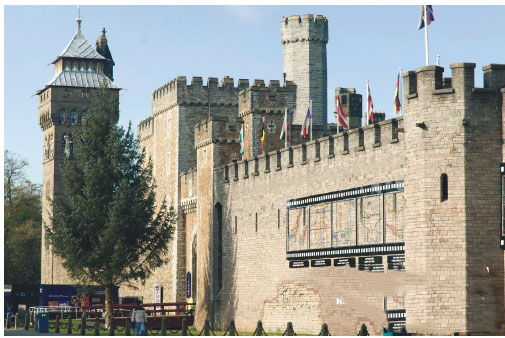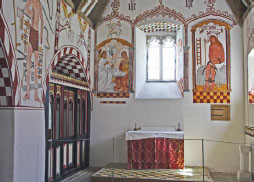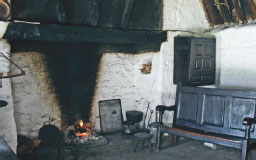
Cardiff Castle, located conveniently in the city centre, draws the crowds.
THERE IS A SHARP CONTRAST between Cardiff and the ancient, cosmopolitan capitals of London and Edinburgh. The Welsh city is young. Cardiff earned its spurs as a port and industrial city—chief point of export for the coal and iron that poured down from The Valleys. The docks built in Cardiff by the Marquis of Bute in 1793 and the development of the railroad to transport minerals down the valleys caused Cardiff’s population and prosperity to explode through the 1800s. It didn’t officially become a city until 1905, though, and was named Wales’ capital in 1955.
[caption id="HistorySportandArtBlendNicelyinWalesCapitalCity_img1" align="aligncenter" width="505"]

PHOTOFUSION/REX/REX USA
Today, Cardiff is a colorful, multi-faceted metropolis of 350,000, booming with Welsh national pride and enthusiasm in the arts, sports and its own vibrant history. There is no pretending that you can actually see Cardiff in a day. Do spend two or three if you have them. You can, however, see quite a sampling of the city in a well-planned day. It’s a matter of choosing from an abundance of riches.
Cardiff’s A-List Visits
For visiting purposes, there are two Cardiffs to see: the city center that spreads around Cardiff’s train station and Bute Park, and Cardiff Bay.
Cardiff Castle makes a good central starting point. Its Norman keep still stands, but this is no medieval ruin. The visionary industrialist Marquis of Bute rebuilt the fortress as a palatial home that combined Regency elegance and his own fantasies. It’s a most unusual “castle” visit.
Just across the street from the castle, Millennium Stadium is home to Wales’ national rugby and football teams. Enthusiasm runs high here; you might want to avoid game day. On the other hand, it’s a rousing experience to hear a stadium full of Welshmen singing “Guide Me, O Thou Great Jehovah.” This September and October, the stadium plays host to eight matches in the 2015 Rugby World Cup.
The National Museum of Wales sits just a couple of blocks away. Dip for as long as you’ve inclination into the rich artifacts, art and displays of Welsh history. It’s open 10-5 Tuesday-Sunday; plan your visit ahead at www.museumwalesac.uk.
Then, head to Cardiff Bay. A century ago this was a bustling industrial port. Smokeless Welsh coal flowed to the Cardiff docks fueling the British wartime navy. Years of late 20th-century decline left the waterfront spiritless before regeneration 20 years ago brought the bay brilliantly to life again. Regarded as one of Britain’s most successful regeneration projects, the story is told in the pod-shaped Visitor Centre. Nearby, the historic clapboard Norwegian Church stands as an emblem of the port’s international past; Roald Dahl used to attend here as a boy. Now, it is an arts center. Perhaps the nation’s premier performing arts venue is the Wales Millennium Centre, home to the Welsh National Opera. A newer arrival still is the Senadd building, home to the National Assembly for Wales, opened by The Queen in 2006.
[caption id="HistorySportandArtBlendNicelyinWalesCapitalCity_img2" align="aligncenter" width="283"]

BARRY BATCHELOR/PA ARCHIVE/PRESS ASSOCIATION IMAGES
Room at the Inn
Not surprisingly, Cardiff is rife with contemporary chain hotels across the budget range. For modern chic, stay at the 5-star St. David’s Hotel on Cardiff Bay. In the center city, for classic Edwardian ambience, both the Angel Hotel and the Royal Cardiff offer style would have appeared in 1530. and location. There are many other options across the comfort and location spectrum. For all manner of planning a stay in Cardiff, it’s www.visitcardiff.com. Cardiff is a busy, active city center. It also has a deserved reputation for being rowdy and noisy on weekend nights with young pub celebrants. If a quiet neighborhood is more appealing to you, take that into consideration.
[caption id="HistorySportandArtBlendNicelyinWalesCapitalCity_img3" align="aligncenter" width="1024"]

DANA HUNTLEY
Just Beyond Center City
Half a mile northwest of city center on Western Avenue (A48), the neighborhood of Llandaff is home to Llandaff Cathedral. The 12th-century cathedral is seat of the Bishop of Llandaff, head of the Anglican Church in Wales. Restored after severe bomb damage sustained in the Cardiff Blitz of World War II, its soaring nave features the dramatic depiction of Jacob Epstein’s “Christ in Majesty.”
On the southwest side of Cardiff Bay, the city has virtually its own seaside resort in Penarth. Since Victorian times, Penarth has offered all the traditional amenities of the seaside, complete with pier, esplanade, shingle beach and wide verandas, only five miles from Cardiff city center.
Just north in the suburb of St. Fagans, the Welsh National History Museum is recognized as one the best open-air folk museums in Europe, recreating life in Wales across 2,000 years of history. Check out the village of Celtic roundhouses and the terrace of miners’ cottages showing how life changed over the centuries. Farmers tend crops and animals, while in the farmhouse, dinner cooks on the open air. This is a world-class visit, but takes several hours at least to do any kind of justice. Open daily 10-5. As at all seven of Wales’ national museums, admission is free at St. Fagans.
Go Exploring the Region
Cardiff is indeed a gateway to Wales. Turn west for Pembrokeshire, “the little England beyond Wales,” and Dylan Thomas country. Nearer at hand, take the A470 north to the Rhondda and the heart of the Valleys. Visit Pontypridd and the discover life in the coal fields at the Rhondda Heritage Park at the Lewis Merthyr Colliery. Follow the A470 to the “Top of the Valleys” road and on to the Brecon Beacons. Or turn east on the A40 to Hereford and The Marches.
[caption id="HistorySportandArtBlendNicelyinWalesCapitalCity_img4" align="aligncenter" width="254"]

DANA HUNTLEY
[caption id="HistorySportandArtBlendNicelyinWalesCapitalCity_img5" align="aligncenter" width="255"]

DANA HUNTLEY
[caption id="HistorySportandArtBlendNicelyinWalesCapitalCity_img6" align="aligncenter" width="256"]

DANA HUNTLEY
[caption id="HistorySportandArtBlendNicelyinWalesCapitalCity_img7" align="aligncenter" width="1024"]

DANA HUNTLEY





Comments